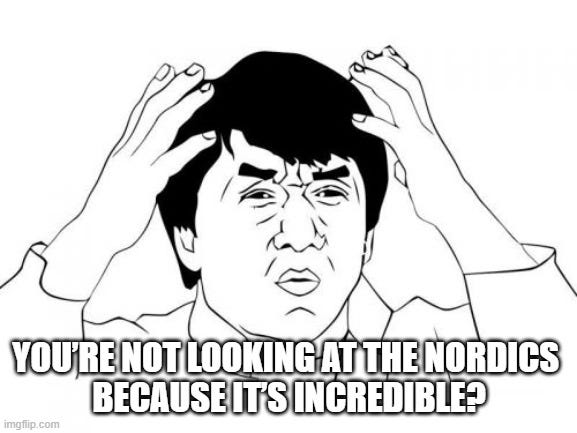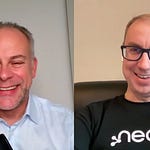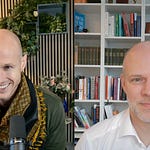Today is a special one as we dive deep on the process and learnings from Isomer Capital’s hot-off-the-press deep dive on the Nordics. Joining us from Isomer Capital, we have with us founding partner Joe Schorge and Principal Chloe Dagnell and Benjamin Rej Notlev, CCO and CIO at TechBBQ, the leading tech conference in the Nordics🔥.
Get your scrolling finger ready, ‘cos this is a long and thorough one (meme-fied for your pleasure as always though). Hope you’ll learn something and that you’ll share it if you do!
Oh! but before we let you get on with your scroll, let’s all celebrate Chloe’s promotion to Principal at Isomer Capital 🥳. She’s an incredibly hard-working champion of European venture 🚀 We’re proud (and happy!) to call her a colleague and honored to have her co-host our series dedicated to Women in European Venture called At The Cap Table.
Table of Contents (read below 👀 )
Announcing EUVC’s First Country Ambassador: Benjamin Rej Notlev 🥳
The LP motivation for diving deep on the Nordics
Crafting a Strategic Approach for First-Time Fund Investors
Isomer’s Nordic deep dive: from 90-odd funds to 12 and then to three or four
Core Findings about the Nordic Venture Market
Learning #1: Micro funds abound in the Nordics, so do the 100'm+ funds, but very few 30 - 100 million euro funds exist
Learning #2: Finland stands out (again)
Learning #3: The Sustainability Funds are very strong
Learning #4: The Nordics is no longer made up by national champions
One word of caution to internationalization though…
Announcing EUVC’s First Country Ambassador: Benjamin Rej Notlev 🥳
This move is not just a mere addition to the team but signifies a deeper alignment of visions and goals in the European startup ecosystem. Benjamin, with his passion for European venture and role as CIO and COO at TechBBQ, has been instrumental in connecting the tech industry, especially in the Nordics.
What is more, Benjamin's association with us isn't new. He has invested actively with us, join us in sparring and we’ve been rooting for each other from the sidelines. With this, we’re taking that relationship to the next level.
"I think there’s a huge potential in community leaders and angels that aren’t currently investing into venture funds due to minimum tickets in the hundreds of thousands, but whose network and expertise is amongst the best. I'm truly passionate about helping bridge this gap - for both sides of the investments”
So what’s next? Well, keep your eyes out and reach out to either of us to get involved in taking European venture to the next level 🚀
but…. now let’s get to it 🤿
The LP motivation for diving deep on the Nordics
The venture capital landscape in the Nordics has been a topic of interest for many LPs and VCs alike. With a rich ecosystem of talent and innovative companies, it's no wonder that the region has caught the attention of investors worldwide. However, the wonders of the Nordics is not where our story starts.
In fact, Joe and Chloe describe in the interview how the motivation to dive deep on the Nordics (or any region for that matter) for an LP typically starts with any of the following three prompts:
A new manager surfaces that looks promising. If this happens, Isomer will dive deep on the region and vertical of that manager to make suire it’s the right one to bet on.
Recommit to a manager where it isn’t a clear no-brainer. While all LPs hope new relations will last forever, this isn’t always the true (ps. remember that a non-recommit can be caused by many other things than lack of performance!)
A portfolio review reveals a gap/opportunity in the market. Note how even this one starts not with a lust for investing in a specific market, but with an internal portfolio review.
That said, venture is always moving and you can’t just ‘cross off’ a region as covered and not revisit it again.
You may think you've met everyone in January of 2022, and by January of 2023 there are 10 new funds that you don't know.
Joe Schorge, Founding GP of Isomer Capital
Well, as Joe would say in the episode, not entirely true actually:
The Nordics have really punched above their weight in producing big important tech companies. Think about the domination of the gaming world, right? You may have shot an angry bird out of a slingshot at some point. You may have listened to music streaming in your car or on your phone. There’s so many places where Nordic tech have made a huge impact, so it's an important ecosystem to be part of.
In fact, we’ll come back to discuss some of the core learnings from Isomer’s recent deep dive on the nordics, but before going there, let’s dive deeper into the underlying process. In fact, I cannot put it better than Joe did in our conversation (god knows me and ChatGPT tried, so instead, I’ll provide his unedited comments:
I think you're getting to the heart of why being a venture capital investor on the LP side is difficult. If you practice what you might call rear-view mirror investing, meaning you simply look at groups that had really strong returns, you may only be looking at the fund vintages that did. When investing as an LP, you really have to consider how they generated those strong returns.
Are all the conditions the same?
What's happened in the market?
What's happened in the pricing of early-stage deals and the founder network?
What's happened in the size specifics of the fund and the team?
Maybe the people who made those great returns aren't there anymore. It sounds obvious, but it isn't obvious because it's based on the idea that we shouldn't make selections without as much knowledge as we can.
And getting to anything close to full knowledge in private markets is incredibly tough. The only way to get there is to try to meet everybody and talk to everybody. But even though you do your best to uncover everything, you must recognize this idea that we're not investing looking backward. You can only use backward data as much as it can predict what could come. And then we're investing forward.
Also, remeber, every new team that we come across has some merit in them. You meet some teams and think:
"Wow, I could really get on board with this. This is a cool idea. It feels like it might fill a bit of a gap in the Isomer portfolio."
But before you get too involved, too lost in that feeling, you have to reflect on, "Okay, do I just have a great connection with this person? Or is this really the best option for our funds?" And that requires you to go out and do a bunch more work to think about,
Does this really fit?
Is this really for us? Or is it another great fund that we would ideally love to back, but there's just not room for it in the portfolio because there's tons of crossover?
We already have a lot of exposure either in that geography or in that sector, and we don't want to build there."
And then there's also some backward reflection that goes into this, such as:
"What have we missed?
What didn't we capture in the Nordics in the last five, ten years?
Who would we have captured the things we missed with?
Who are the new up-and-coming teams that are really looking good in those areas that our portfolio is slightly underweight on?
And as VC fund investors, there can be somewhat of a “I love you, man"-phenomenon. We're all in this business because we're people who like working with bright, ambitious, smart, innovative other people.
You point out that you tend to fall in love with ideas, with people, with concepts, and the danger of that is you get blinded a bit. And we can all fall prey to it.
So what we do is, I say "Oh, I really like this, Chloe. Go up to Stockholm and have a look, you know, and see what you think"
And this part about using the entire team to pressure test is important to us. Independently, we look at ideas, funds, companies, and so on. And if everyone has a similar response, we're probably onto something, but it's a way of trying to control for the "I love you, man"-moment.
And remember, you want to have that “I love you, man”-moment, ‘cos if you have a team of people who aren’t passionate, they won't have this "I love you, man" moment, and then you lose something as well.
Crafting a Strategic Approach for First-Time Fund Investors
We have quite a few LPs who fit this description and many allocate to a strategy like ours and use that as a way to learn.
So, first, let’s get the disclaimers out the way. Joe is one of the founding partners of Isomer Capital, Europe’s most active Fund of Fund dedicated to European Venture Capital. David and I run our own small community of angels that invest in venture funds. In essence, at each end of the spectrum, we do the same thing: provide what we believe is the best possible access point to European venture with a strong risk-adjusted return. So. Obviously we have a chip in this game.
However, I find it too important not to address the dangers of “going it alone” in venture. And there’s no reason why you would, tbh. Whatever you’re into, there’s always someone made just for you.
Why do I say this? Venture firms deliver more than returns. They deliver networks, insights, co-invest opportunities, and community. Each within the specific verticals or markets they focus on.
As a rule, though, the bigger the fund, the bigger the ticket required to access these. You can call it that they scale gets harder to tip in your favor.
Put 1 million in a tier 1 with hundreds of millions in AUM, you might only see a quarterly report on top of your returns.
Put 250k in a first-time manager and you might have a friend for life.
This equation is exactly why we argue wholeheartedly for the partnering approach. Be that with Isomer or us at eu.vc.
Looking for your partner(s), Joe underscores the essence of comprehensive understanding and due diligence, emphasizing the need to immerse oneself in the intricacies of the investment landscape, stressing that every avenue must be explored before making informed decisions. "We've spent many, many years going country by country to understand [each geo]. Because I believe that you can't make a strong selection until you've really understood all the options," Joe elaborates. He suggests, "Meet the funds, go to Helsinki and meet the funds. Go to Copenhagen and meet the funds.” But also understand that you’ll often have to have something more to offer than the money.
Really good funds, maybe they don't need your money, so you have to offer something to them as well.
What we often see is that family offices and wealthy individuals get offers from private banks and from founders in their network. It might look good at face value and come from a trusted source. But to be frank, it comes all too close to being brother-in-law investing.
Isomer’s Nordic deep dive: from 90-odd funds to 12 and then to three or four
In our Nordic deep dive, we've tracked just about 90 funds, and then we start filtering them down, asking ‘who's working in those spaces that we really like and are excited about? What team constructs are in there, that we really feel like, wow, these guys have something, they're gonna be able to access some better deals, some amazing entrepreneurs that our current roster isn't getting to.
So it's really that triaging that filtering down until you feel like; we think we found the team.
Chloe Dagnell
Getting from those 90-odd funds down to the final three or four commits is a grueling process at Isomer. It resembles a sales funnel really. You start with 90 funds and the top and you pare that down by applying filters.
First, we really wanna focus on funds that will be the first professional money into companies.So that tends to bee and pre-seed and, and that takes you naturally to smaller funds.
We’re also want to focus on digital companies. We don’t invest in life sciences. So we cut out those funds, for example, and so you start to pare down on really basic criteria.
Enter, the fit criteria:
Then we're really looking three big pillars of activity:
The first pillar is: How do we make great returns together? And all of the normal LP logic that goes into that, think fund size, number of tickets, reserve ratios, exit assumptions, all those normal things.
Second big pillar is; we already have a portfolio. We've invested quite a lot in this region, so. This thing we're considering, is it actually diversifying or would it overlap at all with all that? You can call it the diversification agenda. And it beats me, but we do turn down very good funds purely on that basis. They're just too similar to something else that we've already invested in which is kind of annoying 'cause nobody likes to turn down a great investment, but the agenda of shots on goal requires that you do.
And the third big area is then what we call the partnership model. Is this a firm we really can partner with? And by doing so, we'll make them stronger, hopefully, and they'll make us stronger. Here we’re looking for that free flow of information and deals in two directions. The ability to do more together over time. And longevity is important here, and we like small funds, so if a fund is getting to the edge of our scope, and the next one will be out of our scope, we’ll be thinking about that pretty carefully because maybe it's a one and done and, and maybe there's versus another group which may stay within our scope for longer.
By applying the fit criteria, Isomer went from 70 funds that were in their broad scope, 36 funds that they wanted to monitor and finally, they came down to 12 “favorites”, so to say.
These 12 are groups we think will be highly productive, will generate high returns and who we could work with.
Butr Isomer can’t write 12 tickets.
I wish we could. That would be kind of easy. But that's not what our LPs are paying us for and that's not a strong construction.
So we've then gotta go through an agonizing process of selecting three to four out of these 12. And they must grant us coverage of the market, but also satisfy all the criteria.
And from here, it’s a really a sit-down debate around where the capital should go. You can almost feel the tension in those debates. At least I can 🤓.
Core Findings about the Nordic Venture Market
So, let’s get to it. I hope the above, while not learnings about the Nordic Market, were helpful. If they were, do share them with someone else who’ll enjoy them🥰
Learning #1: Micro funds abound in the Nordics, so do the 100'm+ funds, but very few 30 - 100 million euro funds exist
The Nordic venture capital landscape, as Joe keenly observes, presents a fascinating tapestry of micro funds and ascending giants, each contributing to the ecosystem's distinctive flavor.
There was a ton of micro funds in the Nordics that once we started looking, we just became more and more aware of.
Chloe Dagnell
That said, there’s a remarkable gap between the micro funds and the large funds, noting "Interestingly enough, you then had a lot of funds that tipped over the one hundred million mark."
This insight underlines a unique opportunity spectrum for Isomer as it’s within this space that Isomer thrives: "There's a lot that have grown a little bit bigger around 120, 130 in size and relatively scarce, which is our sweet spot."
There was, that was a ton of micro funds in, in, in the Nordics that once we started looking, you know, we just became more and more aware of, we we're classifying that as in. Interestingly enough, you also then had a lot of funds that that tipped over the a hundred million mark and within that 30 to a hundred million size, not actually that many funds. I think that was a real insight for us. Right? There's a lot on the very small scale in the Nordics. There's a lot that have, have grown, grown a lot, a little bit bigger around 1 20, 1 30 in size and relatively scarce, which is is our sweet spot.
And so we love to see that. for us, one of the things that we always find is we look at Finland and think it's an amazing ecosystem. It's super exciting. Um, there's a lot of great funds there, a lot of activity, uh, going on. And so we continue to be very, very excited about that market. and for us, maybe Sweden is one of the, the harder markets to access, but is one of the, the highest performing.
Learning #2: Finland stands out (again)
Looking at the specific Nordic markets, the Finnish startup ecosystem stands out as an area of high interest: "For us, one of the things that we always find is that Finland is an amazing ecosystem. It's super exciting. There's a lot of great funds there, a lot of activity going on."
Learning #3: The Sustainability Funds are very strong
In the Nordics, sustainability has become a driving force: "There's a massive strength around sustainability in the Nordics." This strength materializes through the rise of climate funds that have taken the stage, ushering in a strong sense of purpose and impact.
This is likely connected to the fact that the funds in the Nordics were some of the very first to turn around and say; “okay, here is our focused ESG strategy." Long before sustainability became a buzzword, these pioneers were already shaping their investment strategies with a keen focus on environmental, social, and governance considerations.
Similarly, the Nordics' has also shown a dedication to diversity and partnership, which, no doubt, has enriched the startup ecosystem immensely, fostering collaboration and nurturing a tapestry of perspectives.
As the Nordic ecosystem matures the rise of specialized impact funds is noted:
"The Nordic funds have definitely been early, early leaders in this space. And as the ecosystem continues to develop, we will see a lot of impact-led funds and climate funds emerge."
Learning #4: The Nordics is no longer made up by national champions
"We've definitely gone from having many funds that are nationally focused to saying now it is all of the Nordics or some have even gone pan-European."
Indeed, the landscape has evolved. As Benjamin and his colleagues observe, even domestic funds are embracing a broader outlook. The insular approach of solely targeting their home country is being replaced by a more expansive perspective. "Even the very domestic funds, uh, having an outlook on international investment thesis cross-border, at least in the Nordics, but even global."
The deep dive’s insights dovetail seamlessly with these observations, highlighting the overarching theme that tech investment knows no borders. "Tech investing is not a national sport. Founders are not building businesses to dominate their country." This realization has catalyzed a metamorphosis in how funds operate. Rather than focusing solely on their home market, funds now explore adjacent territories that align with their investment theses.
As Joe recounts, the concept of national focus has become nuanced. Deals that transcend borders are no longer exceptions but part of the evolving landscape.
I think pretty much every fund has told us that; ‘Hey, I know, last time we told you we were only focused on Finland, but we've done a deal in Gotenberg.’
And this has important implications:
There was a time not very many years ago, where you probably could do very well by just picking your Swedish fund, your Danish fund, your Finnish fund, and, and that's because most firms are ess than 10 years old and they were getting started and thus they had a more local thesis that reflected their deal flow.
But this actually strikes on an old theme at Isomer:
Tech investing is not a national sport.
Founders are not in the business of building businesses to dominate their country. They're building businesses to build products that can be regional, at least, if not global. To continue with the Angry Birds from our earlier example: We want the world to play angry birds, not just people in Finland.
Therefore, from what I can see over the last five years or so, is that everyone realized that while you may have been focused on your home country and you may have a home country advantage, you also saw some pretty interesting deals within your thesis in the adjoining couple of countries.
And I think pretty much every fund has told us that, ‘Hey, I know that last time we told you we were only focused on Finland, but we've done a deal in Gotenberg because we saw this, you know, we're enterprise software focused and this was right in our zone and we loved it.’
And, and I can give you examples in each country where they've done a deal in another country. So then they evolve and the next fund comes out and they say, ‘well, now we're focused on our home base, but actually we're putting an office and one or two people in, in the next country over.
And that's a pretty universal story.
One word of caution to internationalization though…
The allure of exploring new markets and cities is undeniable, yet the challenge lies in conveying a value proposition that resonates with both founders and investors. As he aptly puts it:
I'm not against expansion in other areas, but I want to hear a really compelling story.
Joe adds depth to the discussion by acknowledging the surge in venture funds since the mid-2000s, leading to heightened competition within domestic markets. This intensified rivalry prompts fund managers to contemplate broader horizons, seeking to diversify their portfolio and nurture potential outliers that might lie beyond their core market.
However, the critical question remains: What sets these expansions apart and makes them strategically viable?
At the very early stages, it's two guys in the garage. They're pre-revenue. They haven't even told anyone what they're doing yet. And in that case, I think you do need to be able to answer how you find that garage and go in there and help them with their product.
That was it for our Nordics Deep Dive 🤓 Join us at TechBBQ together with another 7500+ attendees, 2600 startup reps, 340+ speakers, 620+ Scaleup reps , 880 investors and 150+ media reps.
And just recently, also 4m€ raised! Clearly, TechBBQ has become the heartbeat of the startup and innovation ecosystem in the Nordics.
What began as a humble BBQ gathering for tech enthusiasts and entrepreneurs in 2013, has since evolved into a large-scale summit that draws LPs, VCs, Angels, and founders from around the world for two days of inspiration, networking, and growth.
So… Join us in Copenhagen and use the link below for a 30% discount 👇

















